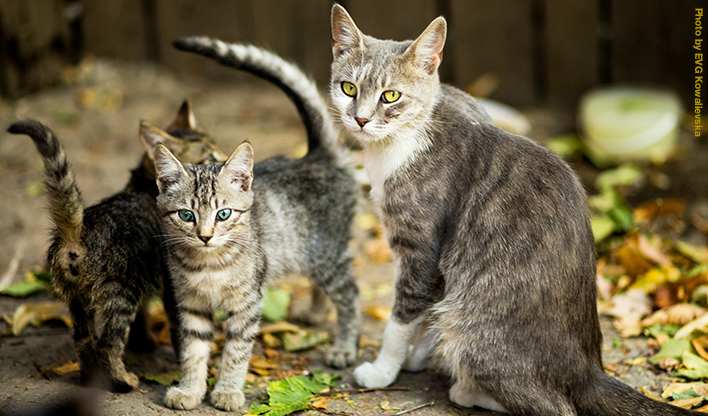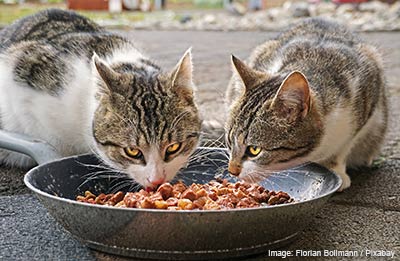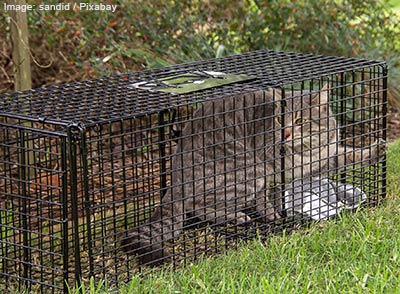Helping feral cats using TNR (Trap Neuter Return)
Chief trapper with the Doncaster South branch of Cat Action Trust 1977 lets us into the secrets of successfully managing a feral cat colony.

Cat Chat is delighted to welcome Karen, Chair and chief trapper at Cat Action Trust 1977 Doncaster South, to give us this fascinating insight into their work helping feral cats:
Trap Neuter Return
Trap, neuter, return (TNR) is one of the most effective ways to help unowned cats, but it can also be one of the most difficult. Tricky locations, humans who are uncooperative, and trap-shy cats are all common issues any trapper will face.
The largest colonies we have dealt with have ranged from 20-30 cats and kittens. As you can imagine this can take quite some time, and it pays to have a week’s break away from the site every so often so the cats don’t get wise to what is happening.
Fact finding
 The first thing we do when alerted to a colony is to fact find. We check where the location is – is it a public place, a workplace, etc., and roughly how many cats there are to help. Sometimes the number of cats can be difficult to assess, especially when they are all the same colour, for example! We also try to find out if there are any pregnant females or kittens, or any with injuries that need to be prioritised.
The first thing we do when alerted to a colony is to fact find. We check where the location is – is it a public place, a workplace, etc., and roughly how many cats there are to help. Sometimes the number of cats can be difficult to assess, especially when they are all the same colour, for example! We also try to find out if there are any pregnant females or kittens, or any with injuries that need to be prioritised.
Planning
Then we devise a plan. Do we have any way to set up a feeding station if there isn’t something already in place? A feeding station can be one of the most important things to succeeding. Cats are very good at knowing when food time is, so by providing food at the same time, in the same place you can get the cats where you need them to be at a time that is suitable.
Once the cats are used to the feeding station, we can start liaising with the vet who is to carry out the neutering. Ideally, the vet will hold an appointment slot open to accept the cat(s), so that once caught, they can go straight there. This minimises the time the cat has to spend in the trap.
Trapping
 Automatic traps are excellent when first starting to manage a colony. We use manual traps if we need to trap a specific cat, and also later on in the TNR process, so that we don’t trap the same cat more than once. A mixture of both types of trap can be successful for a large site with many cats, or for trapping multiple cats at the same time.
Automatic traps are excellent when first starting to manage a colony. We use manual traps if we need to trap a specific cat, and also later on in the TNR process, so that we don’t trap the same cat more than once. A mixture of both types of trap can be successful for a large site with many cats, or for trapping multiple cats at the same time.
The key to successful trapping is to be as quiet as possible (avoid talking, put mobile phones on silent). Success can also rely on having a good, smelly bait such as sardines in tomato sauce or tuna. Southern fried chicken is also very effective. One trick we use is to tie chicken skin to the 'treadle' part of an automatic trap, and while the cat is busy trying to retrieve it, they will often set the trap off without even stepping on it!
Above all of course, patience is needed. Trapping can be a long wait and cannot be rushed. Hurrying, or moving too quickly can spook the cats and make it much more difficult. At this point we will crouch, hide or stand sideways, and we always try to avoid eye contact with the cat. Very often the cat will take their time, circling the trap many times before being brave enough to go in. When they are inside, we reduce their stress level by covering the trap with a large towel or blanket.
Our branch has years of TNR experience, and have learned a multitude of tricks to successful trapping. Essentially though, trapping is rather like fishing: It requires the correct equipment, good quality bait and oodles of patience!
Medical procedures
 As well as neutering, the vet can apply a good quality all round flea and worm treatment. Feral cats are also ear tipped or microchipped. Ear tipping is preferred as it is a clear signal that the cat is already neutered and stops the cats having any unnecessary sedation / anaesthetic in the future.
As well as neutering, the vet can apply a good quality all round flea and worm treatment. Feral cats are also ear tipped or microchipped. Ear tipping is preferred as it is a clear signal that the cat is already neutered and stops the cats having any unnecessary sedation / anaesthetic in the future.
Ear tipping is used worldwide, and is simply a procedure to surgically remove the tip of one of the cat's ears whilst they are anaesthetised for neutering. I was lucky enough to take a trip to Bermuda, and spotted a feral cat hunting in the hedgerow. A little head popped up as we drove slowly past – and there was the ear tip!
The main message
If there was one message we would give to the public, it is this: If you notice a feral cat colony forming in your local area, get help sooner rather than later. The earlier a colony is reported, the easier it can be managed, which is better for your community, and definitely better for the cats.
Can you help?
Having the public’s help is invaluable. They can be called upon to feed the colony when required, and to stop feeding when asked, so the cats are hungry enough to go into the traps. They can also keep an eye on the cats when you are not there.
If you would like to offer your help with managing a feral colony, or find yourself dealing with a feral or semi-feral population of cats, contact your local animal welfare or rescue organisation.
Further reading
Feral Cats - Information
Feral Cats - Adoption, Help & Advice
Contributor: Karen Beevers, Chair & chief trapper at Cat Action Trust 1977 - Doncaster South
Published: September 2022

